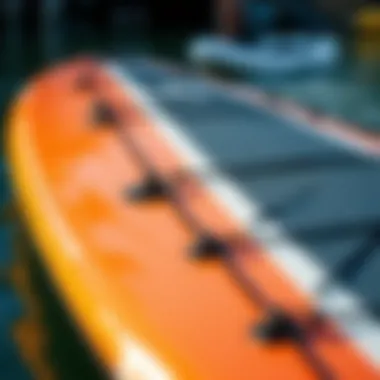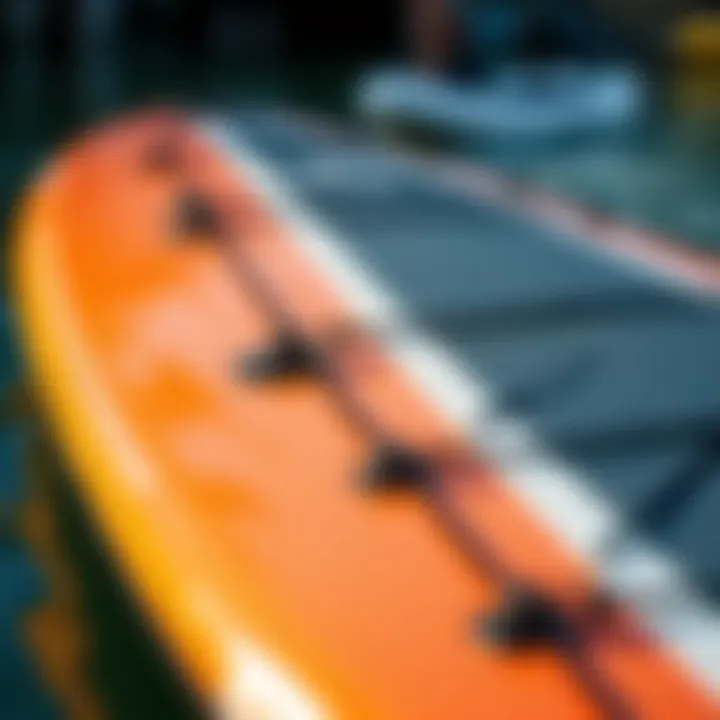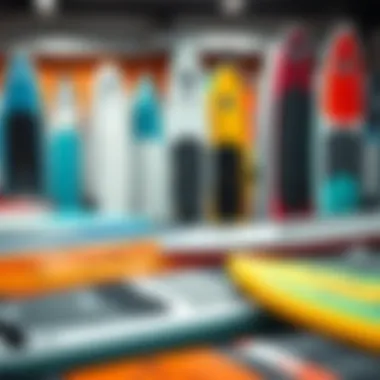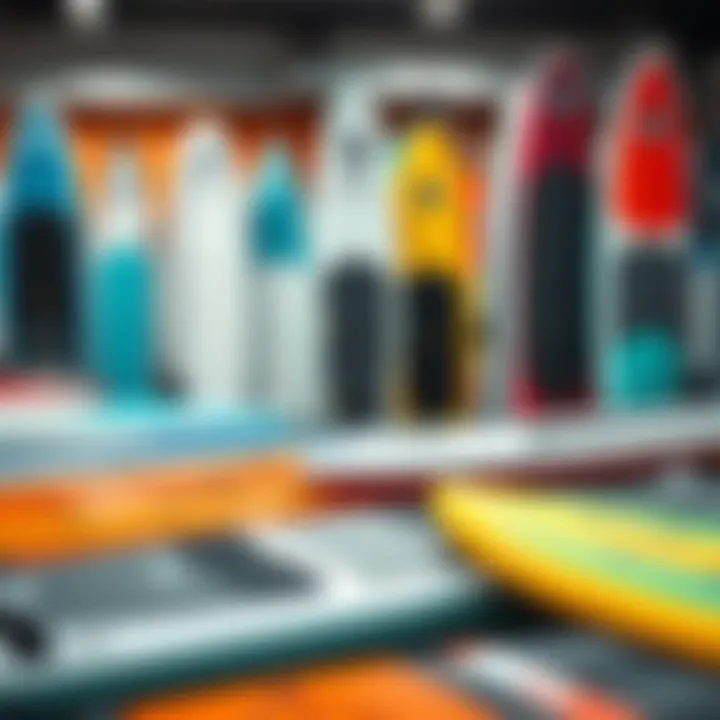Top Inflatable Stand Up Paddle Boards on Amazon


Intro
Inflatable stand up paddle boards (iSUPs) have gained remarkable popularity in recent years, transforming watersports for both casual paddlers and serious athletes alike. They offer budget-friendly options without sacrificing performance, and their portability makes them perfect for those who want to hit the water, no matter where they are. But with a myriad of products available on Amazon alone, potential buyers must navigate the choppy waters of choices to find the right board for their needs.
In this guide, we’ll examine the best inflatable stand up paddle boards currently available. We’ll consider various factors that impact performance, from construction materials to cost, alongside real user reviews, and expert recommendations. We shall also touch on care and maintenance, ensuring that your investment lasts for many summer outings down the line.
What should you expect?
We will delve into expert insights about the latest trends in watersports, safety protocols, and essential gear recommendations for beginners to pros. Each section is designed to give you a structured overview to assist you in making an informed purchase, enabling both seasoned athletes and weekend warriors to enjoy their time on the water to the fullest.
With this understanding, let’s plunge into our first section.
Understanding Inflatable Stand Up Paddle Boards
Inflatable stand up paddle boards (SUPs) have become increasingly popular among both novice and seasoned paddlers. As outdoor activities continue to gain traction, understanding these versatile boards can empower you to make informed decisions for your next adventure. This segment sheds light on what inflatable stand up paddle boards are, outlines their numerous benefits, and categorizes the different types to help you determine which might best suit your needs.
What is an Inflatable Stand Up Paddle Board?
An inflatable stand up paddle board is a lightweight, portable watercraft made from durable materials, primarily PVC, which allows the board to be inflated for use and deflated for storage. Unlike traditional hard boards, inflatable SUPs offer convenience and ease of transportation, allowing enthusiasts to explore waterways that may have been otherwise out of reach. Simply put, these boards are your ticket to effortlessly glide through lakes, rivers, and oceans.
Benefits of Inflatable Paddle Boards
The advantages of inflatable paddle boards can’t be overstated. First off, their portability is a massive selling point. Once deflated, you can roll them up and stash them in a backpack or car trunk, making spontaneous outings a breeze. Furthermore, they are often more stable on water than their solid counterparts, thanks to the air inside which provides buoyancy. Another crucial aspect is durability; the materials used in manufacturing these boards are designed to withstand bumps and scrapes, ensuring they can take a beating without losing performance.
Types of Inflatable Paddle Boards
Understanding the types of inflatable paddle boards available can significantly influence your selection, depending on your usage plans.
All-Around Boards
All-around boards are like the Swiss Army knife of paddleboards, as they cater to a broad range of activities, from casual paddling to light surfing. Their wide profile provides excellent stability, making them a popular choice among beginners or those looking for a multipurpose board. One of the standout features of an all-around board is its versatility; it performs reasonably well in flat water and moderate waves, making it easy for users to explore various environments. However, if you're chasing speed or precision in your paddling, you might find them somewhat sluggish compared to more specialized models.
Touring Boards
Touring boards, on the other hand, are crafted for longer excursions and open water paddling. They are generally longer and narrower than all-around boards, which allows for better tracking and speed. The added length helps cover more distance with each stroke, making them especially suited for fitness enthusiasts or adventurers. A unique aspect of touring boards is their storage options—most models come equipped with bungee cords to enable easy transport of gear, which can be invaluable on longer trips. Nonetheless, their size can be a downside for some, making them less maneuverable in tight spaces compared to all-around boards.
Racing Boards
Racing boards are built with speed in mind. These boards are streamlined, lightweight, and designed for competitive paddling events or those who prioritize performance. Their sleek shape and narrow width enable them to slice through water effectively, translating to higher speeds. A key feature that distinguishes racing boards is their stability at high speeds, requiring riders with a keen sense of balance to fully harness their potential. However, their specialized design may not be the best choice for beginners or recreational paddlers, as they might find such boards less stable in rough conditions.
Yoga Boards
Yoga boards combine the tranquil practice of yoga with the serenity of being on water. These boards typically feature a wider, more stable surface to accommodate practitioners as they transition through their poses. Many models come with additional padding or softer surfaces to enhance comfort during practice. They are not only crafted for fitness but also foster mindfulness as paddlers connect with nature. However, their focus on stability and comfort might come at the cost of speed or versatility, making them less suitable for those looking for high-performance options.
Key Factors to Consider When Choosing
Selecting an inflatable stand-up paddle board might seem like a walk in the park, but it's a bit like trying to find the perfect pair of shoes—different fits suit different activities. These boards aren’t one-size-fits-all. There are crucial factors to weigh that can make or break your paddleboarding experience. By diving into specific elements like board size and volume, material quality, and weight capacity, you can navigate the options with more precision and make an informed choice.
Board Size and Volume
When it comes to paddle boards, size matters. The dimensions directly impact how the board behaves on the water. First off, longer boards are usually faster and better for tracking. If you’re aiming to glide on a calm lake or slice through gentle waves, a longer board (typically 10 to 12 feet) can serve you well. Conversely, shorter boards are more maneuverable, making them great for yoga or quick turns in tight spaces.
Volume is the silent partner in this equation. It essentially refers to the amount of space inside the board, impacting stability and buoyancy. A board with greater volume will support more weight without sinking. Let's say you're planning to paddle with a cooler for a picnic; a board with significant volume ensures you won’t end up doing a surprise deep dive.
Remember that personal choice plays a big role too. If you’re a bigger person or carrying gear, consider a board designed for higher weight capacities. It’s always best to visualize how you plan to use the board before making a decision on size and volume.


Material Quality
Just like any investment, the durability of your paddle board hinges on the materials used in its construction. A common choice is PVC, known for its resilience and puncture resistance. You want something that can withstand the occasional bump against rocks or other boards. Reinforced seams can also add longevity; after all, being in the water often means dealing with unexpected scrapes and scratches.
Some brands offer drop-stitch construction, providing rigidity while remaining lightweight—a game changer for those lugging the board around. If you’re after a high-performance board that can handle rough waters or bumpy trails, investing in a higher-quality material makes a long-lasting difference.
It’s worth noting that not all materials are created equal. Pay attention to the thickness of the PVC. Thicker boards tend to provide more protection, though they may weigh a bit more. As a rule of thumb, don’t settle for a flimsy board; it might save a buck during purchase but cost you much more down the line.
Weight Capacity and Stability
Here lies the crux of many a paddleboarding misadventure: weight capacity and the all-important stability. Each inflatable paddle board comes with a specified weight limit, and abiding by it is critical for both safety and performance. Exceeding that limit can lead to a nail-biting experience, especially for beginners.
A stable board is your best friend when you're out on the water. Stability can depend on the board's width and the positioning of its fins. Wider boards balance better, which can be particularly inviting for beginners or those who might be bringing a dog along for the ride. If you can’t keep your balance, it can be a rather chilly plunge into the water.
Moreover, consider how the board feels under your feet. Test rides—when possible—can really clarify how comfortable you feel standing on it. Ultimately, a board that feels stable and suits your weight requirement will enhance your enjoyment and performance, letting you focus on the sights instead of worrying about your balance.
Choosing an inflatable paddle board isn't just about hitting the water; it's about elevating your entire experience. Prioritize the right factors and you’ll hardly look back.
Top Inflatable Stand Up Paddle Boards on Amazon
When it comes to selecting the right inflatable stand up paddle board, the options available on Amazon can be overwhelming. This section aims to shed light on the best inflatable paddle boards offered on the platform, focusing on specific features, performance, and user satisfaction. In a market that's bustling with choices, knowing the top contenders can make all the difference between an enjoyable paddleboarding experience and a disappointing one.
From the novice paddler to the seasoned athlete, understanding which boards stand out—and why—is crucial. Factors such as robustness, buoyancy, and design can affect your performance on the water. Choosing the right board allows paddlers to focus on enjoyment rather than hassle.
Brand A: Product Overview
Features
Brand A offers a model that shines in various aspects. One notable characteristic is its lightweight construction, making it ideal for easy transportation. Paddlers often recount that this board is effortless to maneuver, even for beginners. A unique feature is its non-slip surface, which enhances grip and stability while navigating through choppy waters. This feature alone has made it a beloved choice for those looking to paddle on lakes or oceans alike.
Pros and Cons
While the advantages of this board are clear—such as its lightweight design and sturdy build—some users have pointed out it doesn't perform as well in high winds. Balancing the trade-offs is essential to spot the most suitable board for your needs. The pros include portability and comfort, while the cons might include vulnerability to strong gusts. Keeping this in mind allows prospective buyers to weigh their options effectively.
User Reviews
Feedback from users regularly highlights how easy the board is to inflate and deflate. Positive notes mention its durability, citing instances of surviving occasional bumps without significant damage. However, there are mentions of occasional difficulty in tracking straight, which could be an issue for those who prefer speed over leisurely paddling. A good mix of praises and critiques is essential for any well-rounded purchasing decision.
Brand B: Product Overview
Features
Brand B has captured attention with its innovative design that incorporates dual-layer construction aimed at providing extra durability. The board includes a built-in fin system that many users find enhances tracking in the water, ensuring a smoother ride. This focus on craftsmanship adds to its desirability, especially for those looking for a board that withstands various environments and conditions.
Pros and Cons
The dual-layer construction is a potent selling point; however, it does come at a slightly higher price point than simpler models. Reviewers often note that while it offers superior durability, it may not be the best choice for casual paddlers looking for a budget-friendly option. Weighing these pros and cons will offer insight into whether this model aligns well with the paddler’s goals.
User Reviews
The user testimonials paint a vivid picture of satisfaction among purchasers. Many commend this board for its transformation in performance when faced with rough water conditions. However, a few voice concerns about its weight, noting that it may not be as convenient to carry on long walks to the water's edge. Overall, the balance of feedback contributes valuable insight into its practicality.
Brand C: Product Overview


Features
Brand C has emerged with an emphasis on versatility, producing a board that caters to both racing and leisure paddlers. This design feature is noteworthy, as it allows users to switch between different paddling styles without feeling limited by equipment. The board's width also provides a stable platform, creating an irresistible appeal for those new to the paddleboarding world.
Pros and Cons
Among its many virtues, the board's adaptability stands out, making it useful for varied water conditions. Yet, it might lack the specialized performance of boards that are strictly for racing or yoga. The reality is that while it may serve several purposes, there are trade-offs in the performance niche. Identifying if a multifunctional board is the right fit can significantly impact its use and enjoyment.
User Reviews
User experiences often emphasize the board's impressive stability, particularly in calmer waters. On the flip side, some have critiqued its gliding speed, suggesting it may not satisfy competitive racers who seek fast-paced performance. This variety of opinions enriches the decision-making process, helping buyers ascertain whether this board aligns with their expectations.
Comparative Analysis
When delving into the realm of inflatable stand up paddle boards, conducting a comparative analysis becomes not just beneficial but essential. This section serves as a guide for discerning paddlers to navigate the myriad options available on Amazon. The critical evaluation of various models highlights their different performance metrics, price points, and user experiences, paving the way for informed decisions.
Performance Metrics
Performance metrics are pivotal when assessing the viability of an inflatable stand up paddle board. They encompass several elements, including speed, stability, and maneuverability. A standout performance metric is speed; boards designed for racing, for example, tend to be longer and sleeker, facilitating faster movements across water. In contrast, all-around boards prioritize stability and ease of use, making them suitable for beginners or leisurely paddling.
When considering stability, one must take into account the board's width and shape. A wider stance increases overall stability, helping paddlers feel secure on the water. Moreover, it's essential to factor in the weight distribution when assessing maneuverability. A light board can twist and turn efficiently but may sacrifice stability as a trade-off. Thus, potential buyers need to evaluate what performance attributes resonate with their paddling intentions.
Price Point Examination
The price point can often signal the differences in quality, even among inflatable paddle boards. Generally, boards range from budget-friendly options to premium selections. This section examines why one may select a higher-priced board.
While cheaper options might seem enticing, they oftentimes compromise on materials and durability. High-quality boards use reinforced fabrics that bolster their resistance against punctures and tears.
- Budget Boards: Often made of lower-grade materials, these may service casual users but fall short in performance and longevity.
- Mid-Range Boards: These typically balance good materials with performance features, often appealing to recreational paddlers.
- Premium Boards: Generally outfitted with advanced technology and superior craftsmanship, these boards attract serious enthusiasts seeking peak performance.
In essence, understanding the price disparities helps purchasers align their choices with their paddling aspirations, ensuring a return on investment that meets their needs.
User Experience Insights
User experiences paint a vivid picture of a paddle board's real-world performance. Reviews and testimonials from fellow paddlers can offer insights that specifications alone may overlook. Specific aspects like comfort, ease of setup, and overall satisfaction emerge from user feedback.
Common sentiments revealed through user reviews often include:
- Comfortability: How does the board feel during extended use? Are there any issues with slipping or discomfort?
- Setup Process: Many paddlers stress the importance of a hassle-free inflation and deflation process. Boards that come with effective pumps and convenient carrying bags enhance overall user satisfaction.
- Versatility: Users often express the value of a board that performs well in varied conditions, whether it be lakes, rivers, or coastal waters.
Quotes from satisfied paddlers can sum up key takeaways:
"This board’s stability is truly unmatched; I feel confident standing even in choppy waters."
Ultimately, gathering insights from users allows prospective buyers to gauge which inflatable stand up paddle boards can fulfill their desires and expectations, delivering not just performance but an enriching experience.
Maintenance and Care of Inflatable Paddle Boards
Taking proper care of inflatable paddle boards is akin to maintaining a vehicle; it ensures longevity and performance. Regular maintenance helps preserve the board's integrity, enhances your experience on the water, and ultimately saves you money in the long run. Following the right cleaning, storage, and repair practices can turn your paddleboarding adventures into a breeze instead of a chore. Investing time in these aspects means you’re not just buying a paddle board, but also a ticket to countless days of fun on the water.
Cleaning Procedures
Cleaning your inflatable paddle board might sound straightforward, yet it’s crucial to get it done right. After every outing, particularly in saltwater or heavy murky environments, you should rinse off the board with fresh water. This practice helps prevent damage and keeps everything in top shape. Here’s a simple routine you can follow:


- Rinse Off: Start by hosing down your board, ensuring all salt, sand, and dirt are washed away. A gentle approach is best; a high-pressure hose can be too harsh.
- Use Mild Detergent: For deeper cleaning, especially if you notice grime accumulating, a mixture of mild soap and water will do wonders. Avoid heavy-duty chemicals, as these can wear down the board's material.
- Scrub Gently: With a soft sponge or cloth, gently scrub the board's surface. Pay special attention to the edges and areas where dirt tends to cling.
- Air Dry: Before storing, allow the board to air dry completely to prevent mold and mildew from setting in.
Maintaining this cleaning routine after your excursions will keep your board in excellent shape and enhance your overall experience.
Storage Guidelines
Proper storage is as essential as cleaning. No one wants to pull out a deflated, worn-out paddle board on a sunny weekend. Here are some tips that can help keep your board in tip-top condition:
- Choose the Right Location: Store your inflatable paddle board in a cool, dry space, away from direct sunlight. A garage or a shed works well. This helps prevent UV damage, which can degrade the material over time.
- Don't Fold, Roll: If possible, roll the board instead of folding it. This avoids creasing in the fabric, which could potentially weaken the seams and cause leaks.
- Avoid Heavy Weight: Keep heavy items off the board when it’s stored. This can easily damage the structure or create pressure points that lead to leaks.
- Use a Bag or Cover: If your paddle board comes with a storage bag or cover, use it. It not only keeps the board protected but also free from dust and debris.
Repair Techniques for Common Issues
Even with the utmost care, wear and tear are a part of any recreational activity. Knowing how to tackle minor repairs can save you from costly professional help. Here’s a guide to handle typical issues with inflatable paddle boards:
- Identify the Problem: Check for punctures or tears regularly, especially after a rigorous outing.
- Patching Material: Most boards come with a patch kit. Make sure you have one handy. If not, universal adhesive patches designed for PVC will work just fine.
- Clean the Area: Before applying a patch, clean the damaged area thoroughly to ensure effective adhesion.
- Follow Instructions: If using a kit, follow the instructions provided. Generally, you’ll apply adhesive to both the patch and the board, press firmly, and let it cure as per instructions.
"An ounce of prevention is worth a pound of cure" – taking these steps helps in keeping your paddle boarding smooth and trouble-free!
Safety Practices for Paddle Boarding
When it comes to paddle boarding, prioritizing safety should be at the top of every enthusiast's list. Whether you’re an athlete, coach, or recreationist, understanding safety practices can greatly enhance your paddle boarding experience. Engaging with the waterways requires a clear focus on preparation and awareness. With the right knowledge, you can significantly reduce risks and ensure that your time on the water is both enjoyable and secure.
Essential Safety Gear
Before setting out, it’s crucial to equip yourself with the right safety gear. Depending on the location and your experience level, having the following items can make a world of difference:
- Personal Flotation Device (PFD): A good life vest isn’t just a legal requirement in many places; it’s your lifeline. Choose a PFD that fits well and is designed for paddling.
- Leash: Worn around your ankle, this keeps you attached to your board, preventing it from drifting away if you fall.
- Whistle: A small, but mighty tool, a whistle can alert others if you find yourself in a tight spot.
- Sunscreen: The sun can be unforgiving. Choose a water-resistant sunscreen to protect your skin from UV rays.
- First Aid Kit: Just in case, it's wise to have a compact first aid kit on hand. Even minor injuries can become problematic if untreated.
Keeping this gear handy is not just about compliance; it’s about making prudent choices that safeguard your well-being.
Paddle Boarding Etiquette
Alongside safety gear, engaging in paddle boarding etiquette respects both the environment and fellow paddlers. Here are some fundamental considerations to keep in mind:
- Know Your Surroundings: Whether you are on a quiet lake or a busy beach, being aware of your surroundings is essential. Stay alert to currents, weather changes, and the patterns of other water users.
- Give Way to Others: Just like on the road, there are right of way rules on the water. Typically, the more maneuverable craft needs to yield to those that are less so. Make sure to be courteous and give space.
- Stay in Designated Areas: Many areas have specific sections for paddle boarding. This helps maintain safety and reduces the chances of accidents. Adhere to these guidelines to keep the water safe for everyone.
- Respect Wildlife: Wildlife is often present near water. It is imperative to give animals their space and refrain from disturbing their habitat.
These safety practices, both in terms of gear and etiquette, ensure a pleasurable paddle boarding experience. Taking them to heart not only fosters an environment of safety but also enhances the camaraderie among fellow enthusiasts in the paddle boarding community.
Finale and Recommendations
In drawing this examination to a close, it becomes evident that selecting the right inflatable stand up paddle board is not merely a matter of picking a random product off the shelf. It requires a thoughtful approach that considers a myriad of factors from performance characteristics to user experience. Given the abundance of options available on platforms like Amazon, buyers should equip themselves with knowledge to navigate their choices effectively.
The importance of this conclusion lies in its role as a synthesis of key insights discussed throughout the article. For instance, individuals interested in paddleboarding must be aware of their specific needs—be it for leisure, fitness, or sporting prowess. Choosing the wrong board can lead to an unsatisfactory experience. It’s like bringing a butter knife to a steak dinner; you want the right tool for the job.
Final Thoughts on Selection
When sifting through the myriad options, the first step is to assess your intentions for paddleboarding. Are you looking for a serene experience on calm waters, or are you geared up for racing thrills? This understanding shapes your selection of board type, size, and materials. For recreational uses, an all-around board typically does ya right. But if you’re aiming for long-distance excursions, considering a touring board may better suit your rigors and expectations.
Most importantly, don't count out user reviews and expert opinions. They often provide insights that product descriptions may gloss over. During the selection process, take notes on:
- Affordability: Value doesn’t always mean the cheapest; it’s about cost-effectiveness and longevity.
- Durability: Materials such as drop-stitch or military-grade PVC can enhance the life of your board.
- Brand Reputation: Well-regarded brands often have better after-sales service.
Ultimately, trust your gut alongside the data. An informed decision will yield more enjoyable outings on the water, helping you rediscover the joy of paddling.
Best Practices for an Enhanced Experience
Securing the right inflatable stand up paddle board is only the tip of the iceberg when it comes to ensuring a fulfilling experience on the water. Once you've selected your board, consider these best practices to elevate every paddle session:
- Regular Maintenance: Just as you wouldn’t neglect your car, keep your paddle board in shape. Rinse it after each use to remove salt or dirt, and store it inflated protects from pests and environmental damage.
- Safety Prep: Always use safety gear like a life jacket, and be aware of weather conditions before venturing out. Paddleboards can catch the wind, so keeping an eye on the forecast can save a lot of trouble.
- Hydration: This one often gets forgotten, but like all outdoor activities, drinking water helps maintain your stamina and focus, especially in the sun.
- Know the Waters: Familiarize yourself with the body of water you’ll be exploring. Every lake or river has its quirks and challenges. For example, swift currents require different techniques compared to calm lakes.
- Take It Easy: Especially for beginners, make use of the time to explore and discover. Rushing into advanced maneuvers can lead to accidents; take time to build your skills.
In following these recommendations, paddleboarding transitions from simply a hobby to a refreshing escape that nourishes both body and spirit. By aligning product selection with practical practices, the joy of paddleboarding can become an enriching aspect of life.







